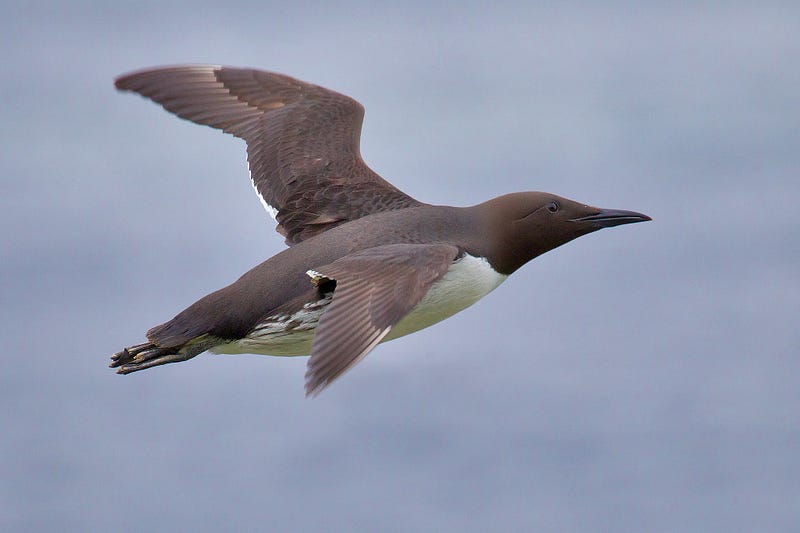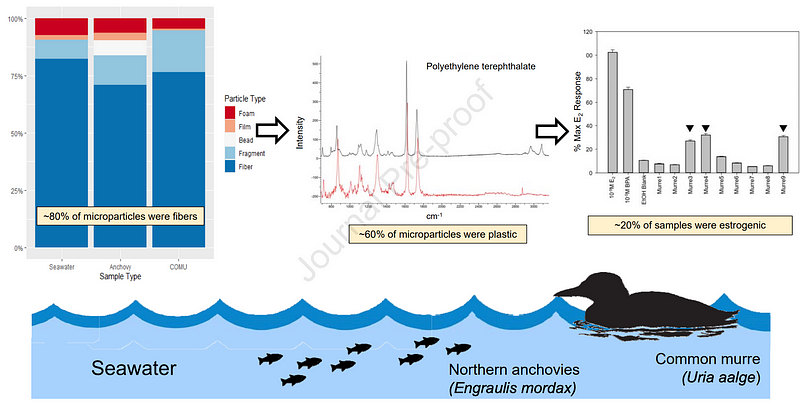Impact of Microplastics on Seabirds in Monterey Bay
Written on
The Widespread Issue of Microplastic Pollution
Recent research highlights the alarming presence of microplastic pollution in California's Monterey Bay, particularly affecting local wildlife. Microparticles discovered in the digestive systems of seabirds, such as the common murre (Uria aalge), have shown the potential to disrupt normal hormonal functions due to their estrogen-like effects.

The study, led by conservation biologist Sami Michishita, reveals that northern anchovies (Engraulis mordax) mistake these plastic particles for food. As these small fish consume microplastics, they inadvertently introduce them into the food chain, leading to increased concentrations in predators like seabirds. Notably, the findings showed microplastics in all examined murres, with nearly 25% of these particles exhibiting estrogenic activity. Common murres, predominantly feeding on anchovies, are particularly affected by this pollution.
Research Overview and Methodology
The research aimed to assess the prevalence, composition, and hormonal activity of microplastics within this vital ecosystem. Samples were collected from the intestines of locally caught anchovies and murres affected by oil spills. The team employed a non-destructive chemical technique to identify the molecular structure of the microparticles.
According to ecotoxicologist Myra Finkelstein, a senior author of the study, "These minuscule plastic particles are releasing substances that may disrupt hormonal balance, potentially impacting reproductive and immune systems." Finkelstein's research emphasizes the need to understand how individual estrogenic effects can influence bird populations, an area that remains inadequately explored.
The first video, Good morning seabirds! | Live From Monterey Bay! offers a captivating look at the seabird populations in this crucial habitat.
Potential Health Implications for Seabirds
Previous studies have established that various plastics leach estrogenic chemicals, which can adversely affect both avian and mammalian health, especially at low exposure levels during critical developmental periods. However, the exact impact of these microparticles on anchovies and murres remains unclear.
"When examining tiny fibers under a microscope, distinguishing between materials like cotton and polyester is challenging," Finkelstein explained. To accurately assess the microparticles, the team collaborated with the San Diego Zoo Wildlife Alliance to evaluate their estrogenic activity. The study found that 58% of anchovies and all murres contained microparticles smaller than 5 millimeters, with the majority being fibers. Of these, over half were identified as plastic, and nearly a quarter demonstrated estrogenic activity.

Understanding the Biological Impact
Determining the health effects of these microplastics on seabirds is complex. It is recognized that chemicals mimicking natural estrogens can disrupt biological functions, but the specific consequences for species like the murres remain an open question.
"The next step is to investigate the potential effects on these birds," Finkelstein stated. "Microplastics are pervasive in our environment, but we must conduct further research to ascertain their biological impact."
The second video, Laysan Albatross at the Monterey Bay Aquarium, provides further insight into the lives of seabirds and their challenges in polluted waters.
The Broader Implications of Plastic Pollution
Moreover, the enticing smell of plastics can mislead seabirds into consuming them, further compounding the issue. "A significant concern with macroplastics is their replacement of natural food sources," Finkelstein noted. "With microplastics, there's the added risk of toxic compounds leaching into the environment."
In summary, this study underscores the urgent need to address microplastic pollution's impact on seabirds in Monterey Bay, revealing the intricate connections between environmental health and wildlife welfare.
Source:
Sami Michishita, Corinne Gibble, Christopher Tubbs, Rachel Felton, Jenessa Gjeltema, Jackelyn Lang, and Myra Finkelstein (2022). Microplastic in northern anchovies (Engraulis mordax) and common murres (Uria aalge) from the Monterey Bay, California USA — Insights into prevalence, composition, and estrogenic activity, Environmental Pollution 120548 | doi:10.1016/j.envpol.2022.120548
Originally published at Forbes.com on 15 November 2022. Keep up with my writing with my free newsletter.